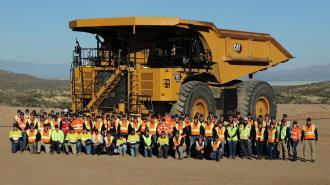Caterpillar, the world’s largest manufacturer of construction equipment, has built its first battery-electric large mining truck — and select customers got to see the massive EV demonstrated at the “mine site of the future.”
“This demonstration is a significant milestone, and we are excited for these trucks to get to work at customers’ sites around the world in the near future,” said Denise Johnson, group president of resource industries at Caterpillar.
The challenge: Caterpillar has sold more than 6,000 of its “793” mining trucks for good reason: the vehicle is an absolute beast, capable of hauling a 252-ton payload — that’s more than the combined weight of 120 average-sized cars.
The 793 is also diesel-powered, though, meaning that all that hauling power comes at the expense of carbon emissions.
Decarbonizing hauling trucks is “one of the most critical actions to take” to clean up the mining industry.
McKinsey and Company
The idea: In 2021, Caterpillar launched the Early Learners program to accelerate the development and validation of electric trucks at its customers’ own sites — this gives Caterpillar a chance to work closely with those customers as the construction industry begins to transition to EVs.
With the help of mining companies in the Early Learners program, Caterpillar developed a battery-electric prototype of the 793, which it recently demonstrated to Early Learner customers.
During this demo, the electric mining truck navigated a 4.3-mile-long course. While fully loaded, it reached a top speed of 37.3 mph, and when tasked with driving up a 1-kilometer stretch with a 10% grade, it reached 7.5 mph.
The demo took place at the Tucson Proving Ground, a testing and validation site that Caterpillar is revamping as the “mine site of the future” with a solar farm, wind turbines, and other tech focused on sustainability.
“The transformation of the Tucson Proving Ground allows Caterpillar to demonstrate our energy transition commitments and serve as a stronger advisor to customers as we navigate the changes together,” said Johnson.
The cold water: The environmental benefits of an EV are reduced if the battery is charged using fossil fuel-generated electricity, so, to have the biggest impact, mining companies would want to power up the electric 793 using some form of clean energy.
That’s if they ever get a chance to buy it. Caterpillar hasn’t revealed whether it plans to actually produce a commercial version of the prototype — or, crucially, what it might cost compared to a traditional 793.
The big picture: Between its diesel-powered equipment and all the fossil fuel-generated electricity it uses, the mining industry is responsible for 1% of global greenhouse gas emissions.
According to a 2021 report by McKinsey and Company, decarbonizing the trucks used for hauling — like Caterpillar’s 793 — is “one of the most critical actions to take” to clean up the industry, as it could cut a mine’s emissions by up to 25%.
Now that Caterpillar has demonstrated its massive, battery-powered mining truck prototype, the next step is getting a version out to working mines, where it can help bring us closer to an emissions-free future.
We’d love to hear from you! If you have a comment about this article or if you have a tip for a future Freethink story, please email us at [email protected].






